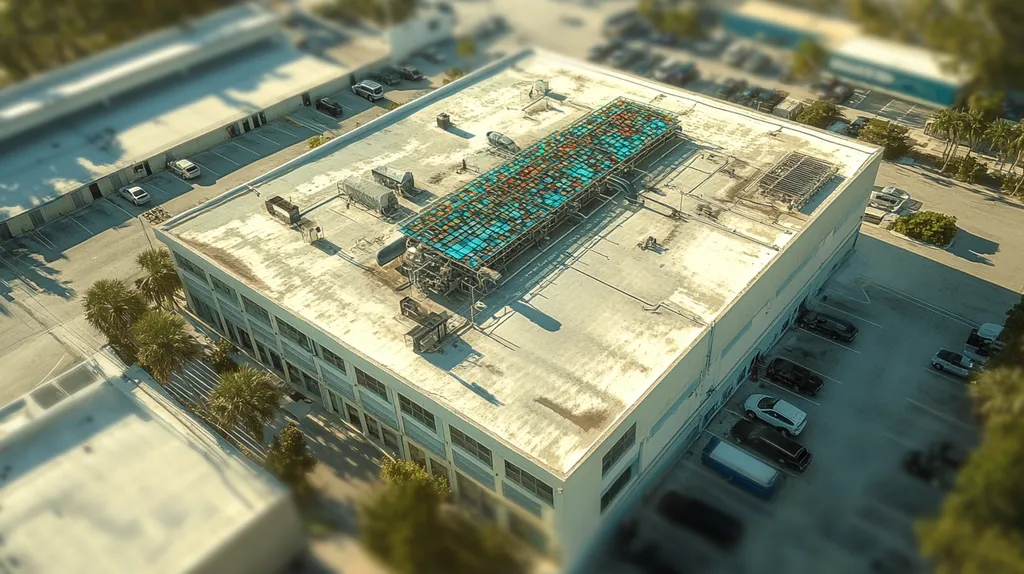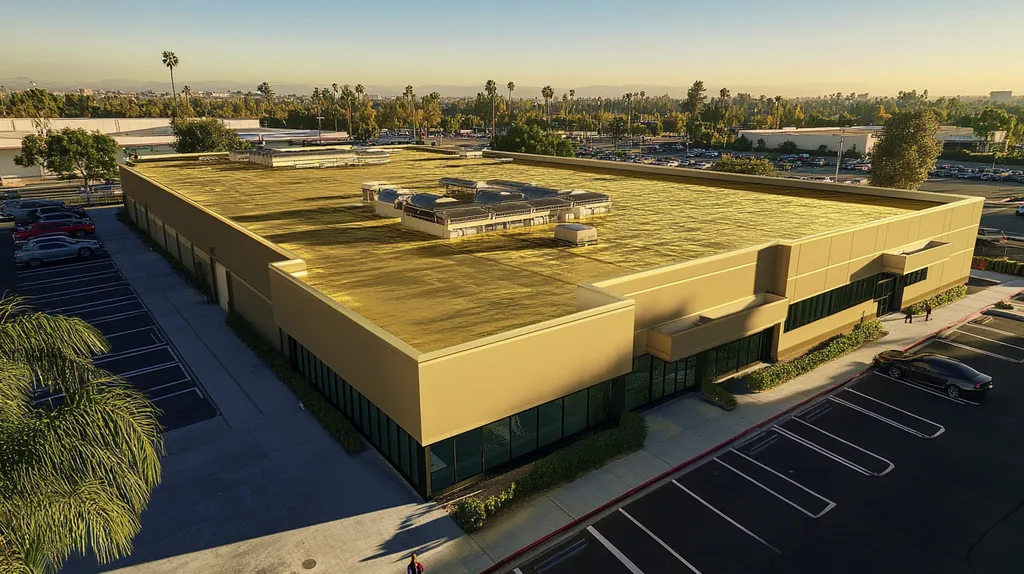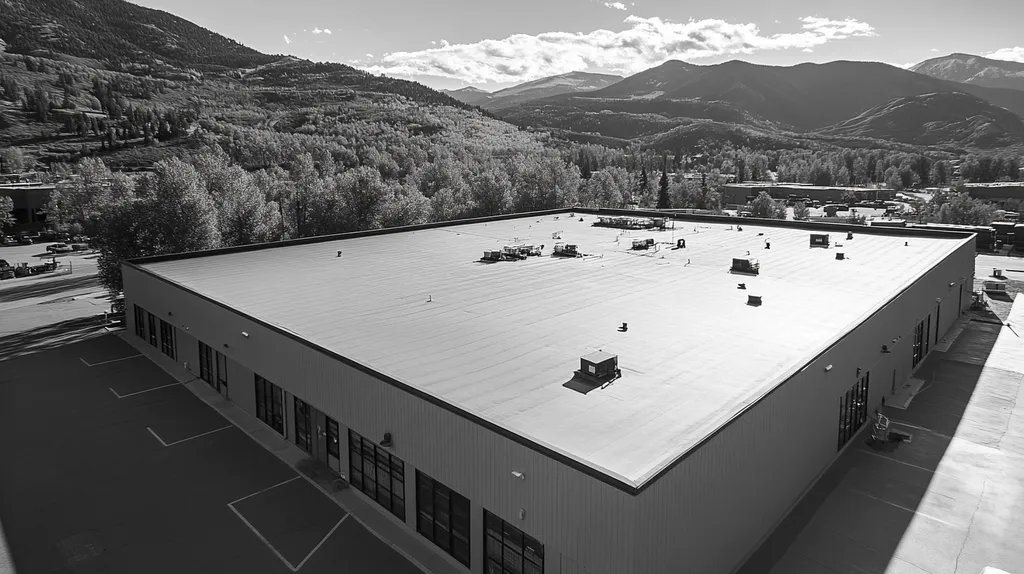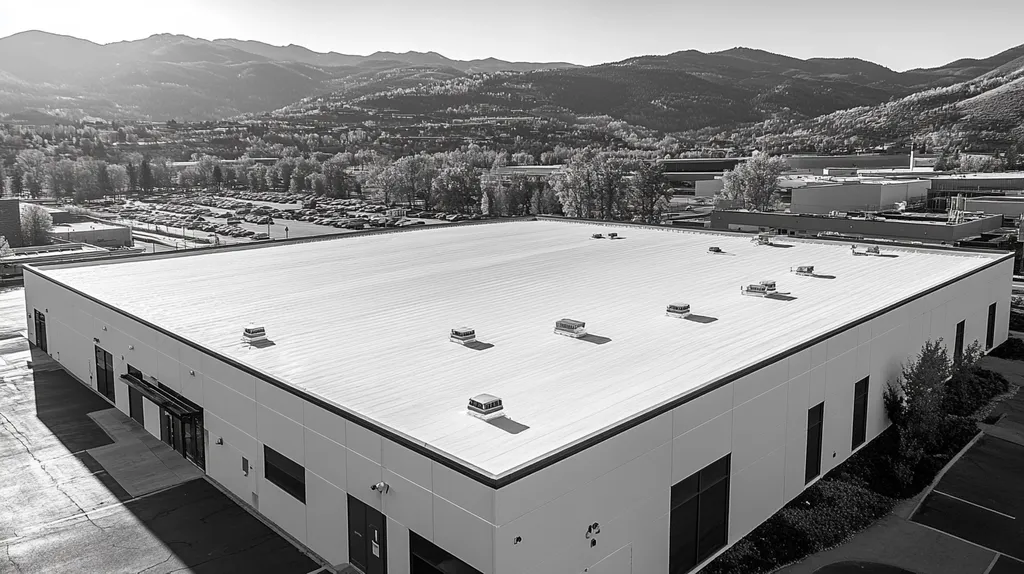Every year, commercial buildings waste millions in energy costs due to poorly insulated roof penetrations – a problem that affects up to 70% of facilities across North America. While these openings for pipes, vents, and equipment are essential, they remain one of the most misunderstood aspects of commercial roofing.
The consequences of improper insulation around penetrations extend far beyond energy loss, leading to structural damage, mold growth, and compliance violations that can cripple operational budgets.
As building technologies evolve and energy codes tighten, facility managers must separate fact from fiction regarding proper insulation practices around roof penetrations. This comprehensive guide examines common misconceptions, their costly implications, and evidence-based solutions for optimal performance.
SECTION 1: COMMON MISCONCEPTIONS
Misunderstandings about insulation around commercial roof penetrations can compromise building integrity and escalate energy costs. Alarmingly, reports indicate that approximately 30% of all commercial roofing failures can be traced back to poorly sealed penetrations. For facility managers and property owners, grasping the intricacies of insulation practices is essential to avoid expensive errors. This section will clarify three widespread myths: neglecting penetration gaps, dismissing vapor barriers, and misapplying insulation materials.
Ignoring Penetration Gaps
One of the most damaging misconceptions is the belief that gaps around roof penetrations can be safely ignored. Many facility managers neglect these gaps, thinking they won’t disrupt the roofing system’s overall integrity. However, unsealed penetrations can serve as gateways for moisture, which can lead to mold growth and significant structural decay.
Research has shown that these unsealed areas can cause a surprising 15% drop in energy efficiency. The resulting drafts strain HVAC systems, causing energy bills to spike. By sealing these gaps, facilities can dramatically improve energy performance and extend the lifespan of their roofs.
Moreover, failure to seal these gaps increases the risk of leaks during heavy rains or snowfall. Water intrusion can severely damage insulation and impact the interior of the building, leading to costly repairs. While sealing gaps might seem like a minor task, neglecting it can have extensive repercussions.
Facility managers should prioritize the sealing of all penetration gaps to support long-term performance. Regular inspections after major weather events are essential to pinpoint potential vulnerabilities created by shifting or settling.
Overlooking Vapor Barriers
A prevalent misunderstanding is the perception that vapor barriers are optional in the insulation process around roof penetrations. Many in the industry underestimate their significance, only to face severe consequences down the line. The truth is that vapor barriers play a crucial role in controlling moisture flow.
When a proper vapor barrier is absent, humidity from the interior can seep into insulation materials, leading to condensation and facilitating mold growth. The costs of mold remediation can be staggering and can disrupt normal building operations.
Additionally, vapor barriers are vital in preserving the insulation’s thermal effectiveness. When moisture saturates the insulation, its performance declines, resulting in increased energy expenses. By correctly installing vapor barriers, facility managers can safeguard their roofs and create an efficient energy system.
Raising awareness among staff about the essential role of vapor barriers can help alleviate these risks. Regular audits of roofing systems should include specific checks for vapor barrier integrity. Ensuring accurate installation during maintenance or new construction is equally vital.
Misusing Insulation Materials
Another widespread misconception pertains to the belief that any insulation material is acceptable for all roof penetrations. Facility managers often choose materials based on cost alone, rather than their suitability for specific applications. This can lead to serious, long-term complications.
For example, using fiberglass insulation in areas prone to moisture can result in the material absorbing water, severely compromising its insulating capabilities. In contrast, closed-cell spray foam insulation is often a better choice for such environments. Selecting the right type of insulation is crucial for optimizing energy efficiency.
The incorrect use of insulation materials can also raise fire safety concerns. Some options may not adhere to local building codes or standards, exposing facilities to serious liabilities. Facility managers must be vigilant in selecting insulation materials that fit the budget while adhering to safety and performance criteria.
Educating personnel on the different types of insulation can facilitate more informed decisions. Engaging with roofing professionals who possess detailed knowledge of various materials can lead to safer and more effective roofing solutions.
SECTION 2: PRACTICAL IMPLICATIONS
Neglecting proper insulation around roof penetrations is not just a minor oversight; it can lead to severe issues that resonate throughout commercial buildings. These problems extend beyond mere aesthetics, impacting operational costs, energy efficiency, and the very integrity of the structure. For example, inadequately insulated penetrations can precipitate moisture buildup, leading to costly roof repairs and a shortened building lifespan. Grasping these practical implications is crucial for facility managers and property owners aiming to protect their investments.
Moisture and Condensation Issues
Moisture infiltration through poorly insulated roof penetrations is a significant concern that can escalate swiftly. When warm, humid air interacts with cold surfaces, condensation occurs, creating a perfect breeding ground for mold and rot. This compromises not only the roofing materials but also poses health risks for building occupants.
Furthermore, moisture accumulation diminishes the insulation’s performance, driving up energy bills and increasing overall operational costs. If left unchecked, these moisture problems could lead to substantial consequences, culminating in premature roof replacement.
Consider a commercial building that allows condensation to accumulate around a rooftop HVAC unit; this could manifest as extensive water damage in the ceiling below. Addressing moisture concerns proactively is essential for maintaining a safe, efficient environment.
Implementing proper insulation techniques is key to preventing these moisture-related issues. Investing in the right materials and installation methods protects structural components and helps maintain a stable interior climate.
Thermal Bridging and Energy Loss
Thermal bridging presents another critical challenge associated with insulation around roof penetrations. When insulation is inadequately installed or completely missing, heat flows through building materials can lead to substantial energy loss. This inefficiency directly affects heating and cooling costs.
For instance, a facility that lacks insulation around vent pipes may experience a sharp rise in energy expenses. Without proper thermal barriers, cold air penetrates during winter, while warm air invades during summer, forcing HVAC systems to work overtime.
Fortunately, effective insulation solutions can significantly reduce these energy losses. Utilizing energy-efficient insulation materials enhances overall building performance and leads to notable cost savings in the long run.
Furthermore, well-insulated buildings are more likely to comply with energy codes, helping facility managers avoid potential fines while increasing marketability.
Structural Integrity Risks
Inadequate insulation around roof penetrations poses a grave threat to a building’s structural integrity. Over time, persistent moisture damage can weaken crucial structural components, leading to safety hazards. A compromised roof structure may result in expensive repairs or even catastrophic collapses.
Facility owners often remain unaware of these risks until visible signs emerge, such as sagging ceilings or noticeable cracks in the walls. By that time, it may be too late to mitigate the damage.
To ensure building longevity, adopting robust insulation practices is essential. A thorough inspection of roof penetrations during maintenance can reveal potential vulnerabilities, allowing for timely mitigation of issues and ensuring occupant safety.
By investing in proper insulation practices now, facility managers not only safeguard their properties but also enhance occupant safety and comfort for years to come.
SECTION 3: COST OF MISINFORMATION
The repercussions of misinformation regarding insulation around roof penetrations can be quite severe. Misguided assumptions may lead to escalating operational costs that facility managers simply cannot afford. A troubling study revealed that inadequate insulation can inflate maintenance expenses by as much as 30%. Understanding these potential pitfalls is essential for making informed choices about insulation practices and strategies.
Increased Maintenance Costs
Misguided beliefs about insulation can significantly raise maintenance costs. Inadequate insulation around roof penetrations can lead to serious issues such as water leaks and energy inefficiencies. These problems often require costly repairs that consume both time and resources, diverting focus from essential preventive maintenance.
Facility managers need to recognize that inadequate insulation creates conditions ripe for frequent repairs, such as sealant failures or even structural damage. The financial burden extends beyond immediate fixes; it also includes hidden costs like operational downtime. Every day a facility remains out of service translates to lost revenue.
Moreover, escalating maintenance demands may force managers to rely heavily on contractors, further inflating expenses. This reactive maintenance approach harms both budgets and staff morale. Understanding the importance of proper insulation is critical for initiating a proactive maintenance strategy that can reduce ongoing costs significantly.
By dedicating time and resources to understand insulation techniques, facility managers can mitigate these rising expenses. Facilities that prioritize informed decision-making often experience substantial reductions in maintenance costs over time.
Reduced Roof Lifespan
Misconceptions regarding insulation can drastically shorten the lifespan of commercial roofs. Adequate insulation around penetrations is vital for a roof’s ability to endure external elements. Without proper insulation, roofs face stresses that significantly accelerate wear and tear, potentially leading to premature failures.
Reports have indicated that roofs with improper insulation could lose up to 20% of their expected lifespan. This loss can result in expensive replacement projects that could have been avoided with appropriate insulating practices. Risking premature roof degradation is a gamble facility managers cannot afford.
Additionally, once a roof begins to deteriorate, the costs multiply. There are disruptions to business operations and the potential for property damage as well. Building owners must recognize the long-term ramifications of their insulation choices to prevent falling prey to misinformation.
To extend a roof’s longevity, decision-makers must invest in education and training regarding effective insulation methods. A proactive stance can significantly enhance roof lifespans while avoiding the substantial costs associated with early replacement.
Compliance and Regulatory Fines
Misinformation can have dire consequences, especially regarding compliance with industry standards and regulations. Many jurisdictions enforce specific insulation requirements to promote energy efficiency and minimize environmental impact. Failure to comply can result in heavy fines that strain organizational resources.
If a facility neglects insulation guidelines, it risks jeopardizing important energy efficiency certifications. Facilities not compliant with standards may forfeit eligibility for valuable energy credits or rebates. This highlights the urgent need for awareness surrounding the insulation needs of roof penetrations.
Facility managers must stay informed about the regulatory landscape and ensure compliance by collaborating with qualified professionals. Engaging the right expertise helps avoid fines and ensures sustainable roofing practices that conform with current codes.
Understanding insulation requirements at roof penetrations will empower facility managers to effectively mitigate compliance risks. Knowledge truly acts as a safeguard against unnecessary financial penalties and reinforces the operational integrity of facilities.
SECTION 4: REALITY CHECK
For facility managers, understanding the implications of proper insulation installation around roof penetrations cannot be overstated. Inadequate insulation can lead to substantial energy loss, affecting heating and cooling stability in commercial buildings. The Department of Energy notes that poor insulation can be responsible for wasting as much as 30% of energy in these settings. By grasping the intricacies of insulation best practices, facility managers can maintain operational efficiency while safeguarding the structural integrity of their buildings.
Importance of Proper Installation
Ensuring proper installation of insulation around roof penetrations is not merely beneficial; it is essential. Any gaps or incorrect seals can facilitate air leaks, causing energy expenses to climb dramatically. For instance, a commercial facility that has inadequately insulated roof penetrations may witness energy bills increasing by thousands of dollars each year.
The effectiveness of an insulation material largely hinges on how accurately it is applied. Even minor misalignments can detract from thermal performance and undermine the entire roofing system. Thus, facility managers must prioritize training for installation teams, ensuring they follow stringent best practices.
Additionally, regular inspections and proactive maintenance of insulation around penetrations are crucial. Catching small concerns before they escalate into costly repairs can save significant resources in the long run. By committing to consistent review and care, facilities not only enhance energy efficiency but also extend the lifespan of their roof systems.
Ultimately, a meticulous approach to both installation and maintenance can yield considerable cost savings while enhancing a building’s overall resilience.
Role of Climate and Building Codes
The significance of local climate in determining insulation strategies around roof penetrations cannot be overlooked. In regions facing extreme weather, more robust insulation systems will be required to minimize energy loss effectively. For example, buildings located in areas with heavy snowfall must select specific insulation materials that can bear the extra weight while providing adequate thermal resistance.
Compliance with building codes is equally important, as they set minimum insulation standards. Falling short in this area can result in hefty fines or the need for costly retrofitting after inspections reveal deficiencies. Therefore, familiarity with local codes is essential for sound insulation planning.
Adapting to changing climate conditions may require updates in insulation technology and methods. Facility managers should stay current on evolving codes and standards to ensure compliance and optimize performance. A growing emphasis on sustainable practices is pushing the industry toward higher insulation performance standards.
Collaborating with local roofing professionals who understand regional requirements can secure insulation solutions that adhere to both performance and regulatory expectations. This strategic approach can reduce the risks of code violations while enhancing comfort indoors.
Impact on Indoor Comfort
The quality of insulation around roof penetrations plays a critical role in the overall comfort of indoor environments. Inadequate insulation can lead to bothersome temperature fluctuations, compromising tenant satisfaction and reducing productivity. A stable and comfortable indoor climate is pivotal for the well-being and effectiveness of building occupants.
Furthermore, effective insulation contributes positively to air quality. Gaps around penetrations can lead to moisture infiltration, which invites mold growth and other health risks. Facility managers must proactively address insulation needs to protect the health and safety of all occupants.
By ensuring consistent indoor temperatures, effective insulation reduces reliance on heating and cooling systems, leading to lowered operational costs. The benefits extend beyond financial savings, contributing to a more sustainable building operation.
In summary, a commitment to high-quality insulation practices around roof penetrations fosters a healthier work environment. This dedication not only improves occupant comfort but also enhances the property’s value and attractiveness in the market.
SECTION 5: EVIDENCE-BASED ALTERNATIVES
Effective insulation solutions around roof penetrations are essential for enhancing energy efficiency and ensuring long-lasting building integrity. Studies show that inadequate insulation at these vulnerable points can lead to energy losses of up to 30%, resulting in significant operational cost increases. Facility managers need to be equipped with the best practices to mitigate this risk. This section discusses three innovative insulation methods that promise improved thermal performance and greater moisture resistance.
Using Spray Polyurethane Foam
Spray polyurethane foam (SPF) stands out as a leading choice for insulating around roof penetrations. Upon application, SPF expands to fill gaps, creating a seamless barrier against air and moisture infiltration. Not only does this method provide effective insulation, but it also enhances the structural stability of the roof system.
The quick curing and superior adhesion properties of SPF make it ideal for various penetrations, including HVAC ducts and plumbing stacks. Its versatility allows it to fit irregular shapes and tight spaces where traditional insulation often falls short.
With a high R-value per inch, SPF delivers exceptional thermal performance. By incorporating SPF into insulation strategies, facility managers can substantially reduce heating and cooling expenses, enhancing the sustainability of building operations.
Moreover, routine maintenance and proper installation of SPF are critical for moisture control, which is vital for prolonging the lifespan of commercial roofs.
Installing Continuous Insulation
Continuous insulation (CI) offers a robust solution for eliminating thermal bridging around roof penetrations. Traditional insulation can leave gaps that compromise overall effectiveness, while CI ensures an uninterrupted insulating layer. This method provides comprehensive thermal protection without the weaknesses of conventional approaches.
Facility managers can integrate CI seamlessly with structural supports, creating a continuous insulating layer around vents, pipes, and other openings. A growing recognition of its efficiency and effectiveness makes CI a best practice in commercial roofing for improving energy performance.
Additionally, compliance with local energy codes when implementing CI may qualify facilities for tax incentives or rebates, enhancing its financial appeal. By boosting energy efficiency, CI not only enhances insulation but also increases the property’s overall value.
When combined with appropriate sealing methods, continuous insulation can significantly reduce moisture-related risks, leading to improved durability for roofing systems.
Sealing Gaps with Foam Packs
Foam packs represent a practical solution for sealing gaps around roof penetrations, providing an extra layer of protection against air leaks. Designed to compress and fill voids, these packs effectively seal openings created by electrical conduits, plumbing pipes, and ductwork, which traditional insulation may not address adequately.
Implementing foam pack sealing enhances the overall energy efficiency of commercial buildings. This method proves particularly advantageous when retrofitting older structures, where existing insulation may be compromised.
Application of foam packs is straightforward and can generally be completed with minimal disruptions during routine maintenance. With proper training, facility staff can easily adopt this practice, significantly improving the insulation strategy without necessitating extensive renovations.
Ultimately, using foam packs not only curtails air leakage but also shields against moisture intrusion, contributing to a healthier indoor environment and reducing the potential for costly future repairs.
SECTION 6: TEST AND VERIFY
In the competitive landscape of commercial property management, oversight of insulation around roof penetrations can make the difference between structural integrity and costly repairs. Neglected insulation can lead to leaks, mold proliferation, and wasted energy, each impacting both finances and safety. Regular inspections, proactive moisture monitoring, and strict adherence to local building codes are non-negotiable practices for sustaining long-term roof performance. This section delves into the critical nature of these practices.
Conducting Regular Roof Inspections
Regular inspections are the cornerstone of maintaining effective insulation around roof penetrations. Experts advocate for inspections at least twice a year, ideally during spring and fall. These inspections should zero in on critical vulnerability points, such as HVAC systems and exhaust vents, which are particularly prone to wear.
During these inspections, facility managers need to look for visible signs of degradation, such as crack formation or bulging membranes around penetrations. Such indicators could signal hidden moisture problems jeopardizing the insulation’s performance. Hiring a professional roofing contractor can provide an in-depth analysis and recommendations for necessary repairs.
Documenting every inspection is crucial; it creates a valuable historical record that aids in identifying trends and planning future maintenance budgets. Maintaining accurate logs of past issues will inform better decision-making and enhance overall roof management strategies.
Additionally, a standardized inspection checklist can help ensure that all team members focus on the same critical elements. This practice minimizes the chances of overlooking potential problems, fostering a culture of diligence that ultimately extends the life of the roof while protecting the property’s health.
Monitoring for Moisture Infiltration
Moisture infiltration presents one of the greatest threats to commercial roofing systems. Once water infiltrates the insulation, the resulting damage can be far-reaching and expensive. Implementing moisture monitoring systems is thus an excellent preventative measure to mitigate issues before they escalate into major problems.
Technological options abound for tracking moisture levels, including moisture sensors and thermal imaging devices. These innovative tools make it easier to identify areas with elevated moisture content, allowing facility managers to intervene swiftly. With a solid monitoring plan in place, the risk of significant water damage is drastically reduced.
In addition to technological solutions, visual inspections form a critical aspect of moisture management. Special focus should be directed toward seams, loose flashing, and any growing disturbances in the roofing material. A proactive visual approach can prove invaluable in mitigating costly damage from prolonged water exposure.
Early intervention is essential when moisture is detected. Quickly addressing any moisture concerns can result in substantial long-term savings. Establishing a clear response protocol ensures that property managers can act decisively when issues arise, preventing escalated damage and minimizing future repair costs.
Ensuring Compliance with Local Codes
Staying compliant with local building codes is not just a regulatory burden; it is critical for the endurance of the roofing system. Numerous codes exist to safeguard property owners against the hazards associated with improper insulation methods and roof penetrations. Understanding and adhering to these regulations is vital for effective roof management.
Facility managers must keep abreast of any changes to local codes concerning insulation materials and practices. Disregarding these guidelines can result in compliance problems, including hefty fines. Furthermore, failure to comply can complicate future insurance claims tied to roof leaks or damage.
Engaging a knowledgeable roofing contractor can streamline adherence to these regulations. An experienced professional will be well-informed about current standards and ensure that every aspect of the installation adheres to or exceeds these benchmarks. Regular training sessions for maintenance staff can further help maintain compliance.
Lastly, conducting periodic audits is necessary for verifying compliance with local codes. Documenting these audits not only serves as proof of compliance but also prepares the property for any potential inspections by local regulatory bodies. Maintaining adherence is integral to effectively managing commercial roofs.
Looking Ahead
With energy costs rising 15-30% annually due to poor insulation practices, facility managers can no longer afford to ignore proper penetration sealing techniques.
The evidence is clear: inadequate insulation around roof penetrations leads to structural damage, compliance violations, and dramatically shortened roof lifespans that can cost facilities millions in premature replacements.
As building codes evolve and energy efficiency standards tighten, maintaining proper insulation around penetrations has moved from a best practice to a critical requirement.
By implementing evidence-based solutions like spray foam insulation, continuous barriers, and regular testing protocols, facility managers can protect their properties while reducing operational costs for decades to come.
The future of commercial roofing depends on getting these fundamental practices right today.
FREQUENTLY ASKED QUESTIONS
Q. What are common misconceptions about commercial roof insulation?
A. Many believe that gaps around roof penetrations are negligible, but they can lead to significant energy loss and roof damage. Proper sealing of these gaps is crucial for maintaining energy efficiency and preventing moisture issues, which can ultimately lead to costly repairs and shorter roof lifespan.
Q. How does improper insulation affect industrial roofs?
A. When insulation is neglected, it can cause moisture problems and energy inefficiencies, leading to higher operational costs. Without proper insulation around roof penetrations, structural integrity can be compromised, increasing the risk of significant repairs and threats to safety.
Q. What are the costs of misinformation regarding commercial roof insulation?
A. Misleading beliefs about insulation can substantially inflate maintenance costs and lead to a shortened roof lifespan. Failing to invest in proper insulation can result in frequent repairs and higher operational costs, which ultimately strain facility budgets and disrupt business operations.
Q. Why is proper insulation installation important for commercial roofs?
A. Proper installation is essential for preventing air leaks, which can dramatically increase energy costs. The effectiveness of insulation depends on accurate application, as even small gaps can allow heat loss, directly impacting comfort and increasing reliance on HVAC systems.
Q. What innovative insulation methods are available for commercial roofs?
A. Innovative options include spray polyurethane foam, which expands to seal gaps effectively, and continuous insulation, which eliminates thermal bridging. Both methods enhance energy efficiency and moisture resistance, offering substantial long-term cost savings when applied correctly.
Q. How can facility managers ensure compliance with building codes?
A. Facility managers must stay informed about local building codes concerning insulation practices. Collaborating with qualified roofing contractors can ensure adherence to regulations, while regular audits can help verify compliance and prepare for potential inspections, protecting facilities from fines.
Q. What other maintenance practices are essential for commercial roof success?
A. Regular inspections and moisture monitoring are critical for preserving roof integrity. Facility managers should document inspections and conduct tests to catch potential problems early. Implementing these proactive strategies can prevent escalated damage and maintain operational efficiency.











